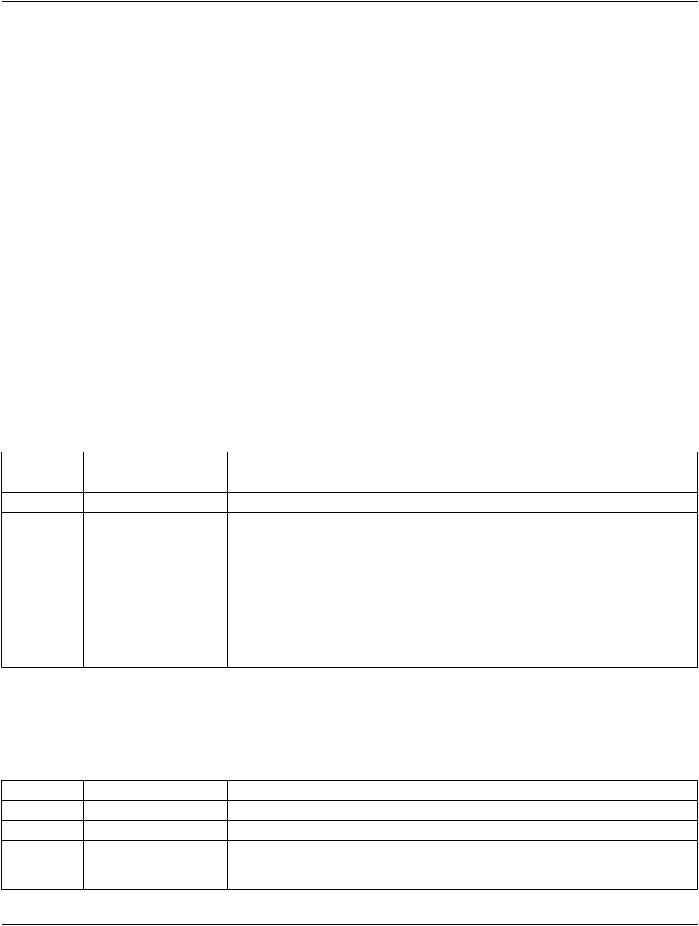
PS-2020a / part08
.pdf
DICOM PS3.8 2020a - Network Communication Support for Message Exchange |
Page 61 |
B Abstract and Transfer Syntaxes (Informative)
B.1 Abstract Syntax Definition
An Abstract Syntax is the specification of Application Layer data elements with associated semantics or Application Layer protocol control information by using notation rules that are independent of the encoding technique used to represent them.
Note
In particular, it allows the communicating Application Entities to negotiate an agreed set of DICOM Data Elements (e.g., from a specific version of the Data Dictionary) and/or Information Object Class definitions.
B.2 Transfer Syntax Definition
A Transfer Syntax is a set of encoding rules able to unambiguously represent the data elements defined by one or more Abstract Syntaxes. In particular, negotiation of Transfer Syntaxes allows the communicating Application Entities to agree on the encoding techniques they are able to support (e.g., byte ordering, compression, etc.).
B.3 DICOM Abstract and Transfer Syntax Names Encoding and Registration
The Abstract and Transfer Syntax Name structure is based on the OSI Object Identification (numeric form) as defined by ISO 8824. Abstract and Transfer Syntax Names are registered values as defined by ISO 9834-1 to ensure global uniqueness. Abstract and TransferSyntaxNamesareencodedasdefinedinISO8825(ObjectIdentifiersofnumericform)whentheOSInetworkcommunication support is used as defined in Section 8. They are encoded as defined in Annex F when the TCP/IP network communication support is used as defined in Section 9.
B.3.1 DICOM Registered Abstract and Transfer Syntax Names
The organization responsible for the definition and registration of DICOM Abstract and Transfer Syntax Names is NEMA. NEMA guarantees uniqueness for all DICOM Abstract and Transfer Syntax Names. A choice of DICOM registered Abstract and Transfer Syntax Names related to a specific version of the DICOM Application Entities, as well as the associated negotiation rules, are defined in PS3.4 for Abstract Syntaxes and PS3.5 for Transfer Syntaxes.
B.3.2 Privately Defined Abstract and Transfer Syntax Names
PrivatelydefinedAbstractandTransferSyntaxNamesmayalsobeused,however,theywillnotberegisteredbyNEMA.Organizations that define private Abstract and Transfer Syntax Names are responsible to obtain their proper registration defined for OSI Object Identifiers. National Standards Organizations representing a number of countries (e.g., UK, France, Germany, Japan, USA, etc.) to the International Standards Organization act as a registration authority as defined by ISO 9834-1.
Note
For example, in the USA, ANSI assigns (for a fee) Organization Identifiers to any requesting organization. This identifier is made of a series of four numeric components; 1 (identifies ISO), 2 (identifies the ISO member bodies branch), 840 (identifies ANSI as the ISO member body representing the USA), and xxxxxx (identifies a specific organization and is issued by ANSI). Such an identifier may be used by the identified organization as a root to which it may add a suffix made of one or more numeric components. The identified organization accepts the responsibility to properly register these suffixes to ensure uniqueness.
- Standard -

Page 62 |
DICOM PS3.8 2020a - Network Communication Support for Message Exchange |
- Standard -

DICOM PS3.8 2020a - Network Communication Support for Message Exchange |
Page 63 |
C DICOM Addressing (Normative)
C.1 DICOM Application Entity Titles
A DICOM Application Entity Title uniquely identifies a service or application on a specific system in the network. Application Entity Titles are independent of network topology so a device may be physically moved while its corresponding Application Entity Title may remain the same. See PS3.5 for the encoding of DICOM Application Entity Titles.
Note
DICOM Application Entity Title was called Logical Address in the ACR-NEMA Standard.
DICOM Application Entity Titles are used in three instances of communication:
a.to identify the Called/Calling Application Entities. They are used to establish an association and to ensure that the association is established with the expected application.
b.to identify the originator and intended destination of DICOM Retrieve Services (see PS3.4). They are conveyed in DICOM Commands with messages of the DIMSE C-MOVE and C-STORE Services exchanged over an established association.
c.to identify the location of a Retrieve Service SCP for one or more SOP Instances. They are conveyed in DICOM DataSets of various services.
C.2 Naming and Addressing Usage Rules
DICOM Application Entity Titles are used in the Called/Calling Application Entity Title fields of the Upper Layer Service, in the Move DestinationandMoveOriginatorApplicationEntityTitledataelementsintheDICOMMessageCommandSet,andinvariousAttributes of the DICOM Message Data Set.
Note
1.A single Application Entity Title can be associated with multiple network addresses assigned to a single system (e.g., multi-homed host).
2.A single Application Entity Title can be associated with multiple TCP Ports using the same or different IP Addresses.
3.A single network access point (IP Address and TCP Port) can support multiple Application Entity Titles.
A DICOM system on a network may support several application processes identified by different DICOM Application Entity Titles.
Upon receiving an association request, the Called Application Entity Title shall be validated so an association can be rejected when the corresponding local application does not exist.
- Standard -

Page 64 |
DICOM PS3.8 2020a - Network Communication Support for Message Exchange |
- Standard -

DICOM PS3.8 2020a - Network Communication Support for Message Exchange |
Page 65 |
D Use and Format of the A-ASSOCIATE User Information Parameter (Normative)
This parameter allows for the negotiation of a number of features related to the communication of DICOM Application Entities at as- sociation establishment.
D.1 Maximum Length Negotiation
This negotiation allows the receivers to limit the size of the Presentation Data Values List parameters of each P-DATA Indication. Theassociation-requestorshallspecifyintheuserinformationparameteroftheA-ASSOCIATErequestprimitivethemaximumlength in bytes for the PDV list parameter it is ready to receive in each P-DATA indication. The association-acceptor shall ensure in its fragmentation of the DICOM Messages that the list of PDVs included in each P-DATA request does not exceed this maximum length. Likewise, the association-acceptor can specify in the user information parameter of A-ASSOCIATE response primitive the maximum length in bytes for the PDV list parameter it is ready to receive in each P-DATA indication. The association-requestor shall ensure in its fragmentation of the DICOM Messages that the list of PDVs included in each P-DATA request does not exceed this maximum length. Different maximum lengths can be specified for each direction of data flow on the association.
The Maximum Length Item support is required for all DICOM V3.0 conforming implementations.
D.1.1 Maximum Length Sub-Item Structure (A-ASSOCIATE-RQ)
The Maximum Length Sub-Item shall be made of a sequence of mandatory fixed length fields. Only one Maximum Length Sub-Item shall be present in the User Data information in the A-ASSOCIATE-RQ. Table D.1-1 shows the sequence of the mandatory fields.
Table D.1-1. Maximum Length Sub-Item Fields (A-ASSOCIATE-RQ)
Item bytes |
Field name |
Description of field |
1 |
Item-type |
51H |
2 |
Reserved |
Thisreservedfieldshallbesentwithavalue00Hbutnottestedtothisvaluewhenreceived. |
3-4 |
Item-length |
This Item-length shall be the number of bytes from the first byte of the following field to |
|
|
the last byte of the Maximum-length-received field. In the case of this Item, it shall have |
|
|
the fixed value of 00000004H encoded as an unsigned binary number. |
5-8 Maximum-length-receivedThis parameter allows the association-requestor to restrict the maximum length of the variable field of the P-DATA-TF PDUs sent by the acceptor on the association once established. This length value is indicated as a number of bytes encoded as an unsigned binary number. The value of (0) indicates that no maximum length is specified. This maximum length value shall never be exceeded by the PDU length values used in the PDU-lengthfieldoftheP-DATA-TFPDUsreceivedbytheassociation-requestor.Otherwise, it shall be a protocol error.
D.1.2 Maximum Length Sub-Item Structure (A-ASSOCIATE-AC)
The Maximum Length Sub-Item shall be made of a sequence of mandatory fixed length fields. Only one Maximum Length Sub-Item shall be present in the User Data information in the A-ASSOCIATE-AC. Table D.1-2 shows the sequence of the mandatory fields.
Table D.1-2. Maximum Length Sub-Item Fields (A-ASSOCIATE-AC)
Item bytes |
Field name |
Description of field |
1 |
Item-type |
51H |
2 |
Reserved |
Thisreservedfieldshallbesentwithavalue00Hbutnottestedtothisvaluewhenreceived. |
3-4 |
Item-length |
This Item-length shall be the number of bytes from the first byte of the following field to |
|
|
the last byte of the Maximum-length-received field. In the case of this Item, it shall have |
|
|
the fixed value of 00000004H encoded as an unsigned binary number. |
- Standard -

Page 66 |
DICOM PS3.8 2020a - Network Communication Support for Message Exchange |
|
Item bytes |
Field name |
Description of field |
5-8 Maximum-length-receivedThis parameter allows the association-acceptor to restrict the maximum length of the variable field of the P-DATA-TF PDUs sent by the requestor on the association once established. This length value is indicated as a number of bytes encoded as an unsigned binary number. The value of (0) indicates that no maximum length is specified. This maximum length value shall never be exceeded by the PDU length values used in the PDU-lengthfieldoftheP-DATA-TFPDUsreceivedbytheassociation-acceptor.Otherwise, it shall be a protocol error.
D.2 Extended User Information Negotiation
The user information parameter, of the A-ASSOCIATE primitive, can be extended to support the negotiation needs of DICOM Applic- ation Entities using the UL Service. This will result in the definition of specific user information sub-items. These sub-items shall be assigned unique item-type values registered in PS3.7.
Note
1.The values of the Sub-Items types in the User Information Field are assigned by this Standard in the range of 51H through FFH. Sub-Item values are defined by PS3.7 and PS3.8.
2.Succeeding editions of the Standard may define additional user information Sub-Items in a manner that does not affect the semantics of previously defined Sub-Items. Association acceptors compliant to an earlier edition of the Standard are required to ignore such unrecognized user information Sub-Items and not reject an Association because of their presence.
- Standard -

DICOM PS3.8 2020a - Network Communication Support for Message Exchange |
Page 67 |
EUsageoftheP-DATAServiceBytheDICOM
Application Entity (Normative)
This Annex specifies how DICOM messages are encapsulated into the P-DATA Service by the DICOM Application Entity.
E.1 Encapsulation Rules
DICOM Messages are encapsulated in P-DATA request primitives as the user data of Presentation Data Values (PDV). A DICOM Message is fragmented in Command Fragments and Data Fragments, each placed in a PDV. The same presentation context shall be used for every fragment of the same message (i.e., same Presentation Context ID for the user data of the PDVs containing the fragments of a same message). A PDV User Data parameter shall contain one and only one fragment (either Command or Data) preceded by a Message Control Header. This header will indicate:
a.whether the fragment is of the Command or Data type
b.whether the fragment is or is not the last fragment of a Command/Data Stream of a DICOM Message
A P-DATA request PDV List parameter shall contain one or more such PDV(s) (Message Control Header and a complete message fragment). Each PDV is wholly contained in a given P-DATA request primitive and does not span across several P-DATA request primitives. The PDVs contained in a P-DATA request primitive shall be related to the same DICOM message. Each fragment of a message shall consist of an even number of bytes.
Note
1.No padding is necessary as PS3.5 defines messages on an even byte boundary.
2.The above rules state that each fragment contained in a PDV shall consist of an even number of bytes (only). Therefore, encoding such as Group Number, Element Number, Value Length, etc. (as defined by the DICOM Application Entity, see PS3.5) is not guaranteed to be within the same PDV.
The fragmentation of any message results in a series of PDVs that shall be sent, on a given association, by a corresponding series of P-DATA requests preserving the ordering of the fragments of any message. Furthermore, no fragments of any other message shall be sent until all fragments of the current message have been sent (i.e., interleaving of fragments from different messages is not per- mitted).
It is strongly recommended that two consecutive PDVs in the same P-DATA Request primitive (therefore containing fragments of the samemessageusingthesamePresentationContextID)donotcontaintwomessageControlHeaderswiththesametype(Command or Data). These should have been combined in a single PDV by the sender. However, receivers must be able to receive and process such PDVs.
Note
The above rules allow the sending in the same P-DATA request/indication of a Command fragment in the first PDV (with the last fragment flag set) followed by a Data Fragment in the second PDV (with the last fragment flag set or not). In partic- ular, if the negotiated maximum length for the PDV List parameter of the P-DATA request is sufficient to hold a complete message, a single P-DATA request can be used to exchange an entire message.
Individual PDVs shall not be sent with Presentation-data-value fields consisting only of a single byte containing a Message Control Header, but without any other content in the fragment. These should have been combined with the preceding or succeeding PDVs by the sender.
Note
Eventhoughtheaboverulesprohibitthesendingofan"empty"PDV(suchaswiththelastfragmentflagset),itisrecommended that receivers be able to receive and process such PDVs.
- Standard -

Page 68 |
DICOM PS3.8 2020a - Network Communication Support for Message Exchange |
E.2 Message Control Header Encoding
The Message Control Header is located in front of each DICOM message fragment (see Figure E.2-1). Its presence is mandatory for all DICOM Abstract Syntaxes (see Annex B for further discussion on Abstract Syntaxes).
The Message Control Header shall be made of one byte with the least significant bit (bit 0) taking one of the following values: a.If bit 0 is set to 1, the following fragment shall contain Message Command information.
b.If bit 0 is set to 0, the following fragment shall contain Message Data Set information. The next least significant bit (bit 1) shall be defined by the following rules:
a.If bit 1 is set to 1, the following fragment shall contain the last fragment of a Message Data Set or of a Message Command. b.If bit 1 is set to 0, the following fragment does not contain the last fragment of a Message Data Set or of a Message Command. Bits 2 through 7 are always set to 0 by the sender and never checked by the receiver.
Note
The Message Control Header, in the Transport data flow, is the 1st byte in each PDV. The Transfer Syntax, negotiated at association establishment, defines the encoding for the Command/Data fragment.
PRESENTATION DATA VALUE AND THE MESSAGE CONTROL HEADER
|
|
|
|
|
|
|
|
|
|
|
|
|
|
|
|
|
|
|
|
|
|
|
|
|
|
|
|
|
|
|
|
|
|
Presentation-data-Values (PDV) |
|
|
|
||
|
|
|
|
|
|
|
|
|
|
|
|
|
|
|
|
DICOM message |
|
|
|
|
|
|
|
|
|
|
|
|
|
|
|
|
Command or Data Set Information |
|
|
||||
|
|
|
|
|
|
|
|
|
|
|
|
|
|
|
|
|
|
|
|
|
|
|
|
Message Control Header |
|
|
|
|
|
|
|
|
|
|
|||||
|
|
|
|
|
|
|
|
|
|
|
|
|
|
|
|
|
|
|
|
|
|
|
|
|
|
|
|
|
|
1 |
1 |
|
|
Message Data Set Fragment |
|
||||
|
|
0 |
0 |
|
0 |
0 |
0 |
0 |
|
|
|
|
or |
|
|
||||
|
|
|
|
0 |
0 |
|
|
|
|
|
|||||||||
|
|
|
|
|
|
|
|
|
|
|
|
Message Command Fragment |
|
|
|||||
|
|
|
|
|
|
|
|
|
|
|
|
|
|
|
|
|
|
||
|
|
|
|
|
|
|
|
|
|
|
|
|
|
|
|
|
|
|
|
|
|
|
|
|
|
|
|
|
|
|
|
|
|
|
|
|
|
|
|
|
|
|
|
|
|
|
|
|
|
|
|
|
|
|
|
Bit 0: Command / Data |
|||
|
|
|
|
|
|
|
|
|
|
|
|
|
|
|
|
||||
|
|
|
|
|
|
|
|
|
|
|
|
|
|
|
|
Bit 1: Last / Not Last |
|||
|
|
|
|
|
|
|
|
|
|
|
|
|
|
|
|
||||
|
|
|
|
|
|
|
|
|
|
|
|
|
|
|
|
|
|
|
|
Figure E.2-1. Presentation Data Value and the Message Control Header
- Standard -

DICOM PS3.8 2020a - Network Communication Support for Message Exchange |
Page 69 |
F DICOM UL Encoding Rules for Application Contexts, Abstract Syntaxes, Transfer Syntaxes (Normative)
F.1 Encoding Rules
Application Context Names, Abstract Syntax Names, Transfer Syntax Names, and Service Class UIDs are OSI Object Identifiers in a numeric form as defined by ISO 8824. The encoding of these names in the DICOM UL protocol is specified in this Annex.
Each component of a Name or UID is encoded as an ISO 646:1990-Basic G0 Set Numeric String of bytes (characters 0-9). Leading 0's of each component are not significant and shall not be sent. Components shall not be padded. Components shall be separated by the character "." (2EH). "Null" components (no numeric value between two separators) shall not exist. Components with the value zero (0) shall be encoded as (nnn.0.ppp). No separator nor padding shall be present before the first digit of the first component or after the last digit of the last component.
Note
1.The string "1.2.840.123456.0.21.4" encoded as an ISO 646:1990-Basic G0 Set character string conveys the following UID or Name with the following sequence of Object Identifier components: { (1), (2), (840), (123456), (0), (21), (4) }.
2.The above rules have been made to simplify performing the comparison of UIDs.
DICOMApplicationContextNames(rootplussuffix)shallnotexceed64totalcharacters(digitsandseparatorsbetweencomponents).
DICOM Abstract and Transfer Syntax Names (root plus suffix) shall not exceed 64 total characters (digits and separators between components).
- Standard -

Page 70 |
DICOM PS3.8 2020a - Network Communication Support for Message Exchange |
- Standard -
